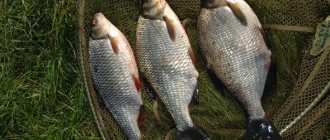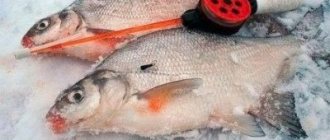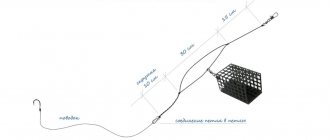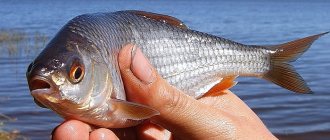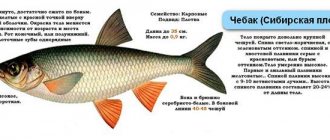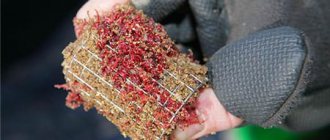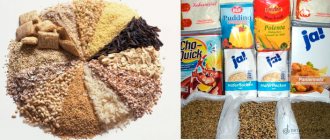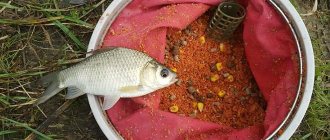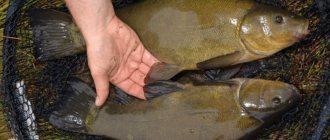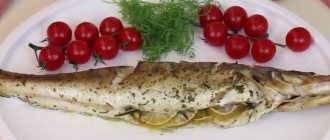Making bait for roach in winter with your own hands at home is a working option for the amateur fisherman. Fishing stores are overflowing with ready-made mixtures. The authors of YouTube videos encourage the use of factory bait, forgetting to mention that they receive an affiliate commission for advertising this mixture. This does not mean that store-bought baits are bad. There are times when their use is advisable.
Winter bait for roaches is a whole ritual. In different bodies of water and under different fishing conditions, a certain recipe or mixture will work better than others. To detect this, several kilograms of feeding mass are consumed over several fishing trips. And for an amateur fisherman, constantly using store-bought options is simply too expensive. What will you choose for lunch - good natural food or a plastic doshirak with a sausage made from a protein substitute? Fish is also a living organism, and properly prepared bait from natural ingredients will outshine store-bought mixtures with dyes and food additives.
Catching and feeding tactics
Bait for roaches in winter is not just porridge poured into a hole to attract fish. This approach is unlikely to lead to roach biting; small crucian carp will most likely gather on the lumps of stuck together bait. Roaches are active in winter and their tastes are very specific. There are a million recipes for baits and flavors for fishing. To be successful in this matter, especially on an unfamiliar body of water, when the preferences of the roach are unknown, the fisherman develops his own algorithm for the use and composition of bait.
Despite the variety of options, there are some mandatory points specifically for roach. They are determined by the peculiarities of winter behavior, which must be taken into account - the entire concept of proper winter bait for roach is based on this. Let's figure out what kind of bait roach likes in winter, as well as how to properly feed this fish in winter under different fishing conditions.
Current feeder
Subtleties of feeding in winter
With the arrival of winter, the roach begins to change its preferences in choosing habitats, and increasing hunger forces it to actively move around the reservoir in search of food. If it is absent, then the fish will definitely change its location and go to a more promising point. For this reason, the use of bait for roach in winter is a necessary necessity to attract fish. Its task is to stimulate a special appetite and increase activity.
Good compounds are sold in various fishing stores, but it makes sense to try making them yourself. To do this, you need to know certain tricks and proven recipes, observing the correct ratio of ingredients of animal and plant origin. It is also important to use water responsibly, because the thickness of the mixture should be medium so that when immersed in a body of water it creates a cloud of turbidity. Dilution with liquid occurs directly at the hole, after which the bait balls are thrown into the water column.
When feeding roach, it is necessary to take into account a number of features related to fishing conditions:
- If you are fishing in a still pond, then the mixture should be poured directly into the hole. The composition is pre-prepared and then lowered into the reservoir in small lumps or balls, as well as a special feeder.
- If fishing takes place in strong currents or great depths, then you cannot do without using feeders. As soon as the mixture is at the bottom, the feeder can be released from the feed with a slight tug of the hand. In this case, the composition will not just fall to the bottom and be carried away by the current, but will create a special spot that will arouse the fish’s interest.
In winter, roaches are especially attracted to animal ingredients, for example: bloodworms or maggots. Towards the end of the season, it is advisable to add earthworms and all kinds of larvae to the bait mixtures, although plant baits can also play a decisive role. Semolina and batter perform especially well: such components interest even the most capricious roach. Unfortunately, there are no universal recipes for preparing bait, because depending on the reservoir, bait is created experimentally.
When fishing in strong currents
Bait in winter when there is a current will only be effective if placed correctly. At shallow depths and medium currents, it can be delivered to the bottom using the standard method - a dump truck. The mixture needs to be dense and sticky enough so that the force of the jet does not immediately wash away the lump and carry it out of the fishing zone.
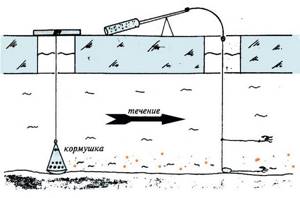
Feeding roach in the current
In a strong flow, it is better to use a special feeder for the current, lowered into the water through a separate hole above the traps. In this case, a trail of small particles in the water and heavy pieces rolling along the bottom will form. It is important that the bait of the fishing rod is located in it. On bottom gear in winter, ordinary feeders are used instead of sinkers. On such a rig, it would be logical to use a lead.
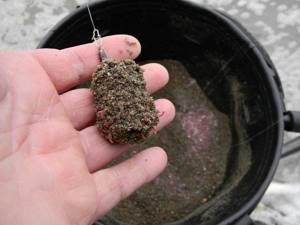
Using a feeder feeder
For fishing in still water
If in the current you can get confused with the consistency (the current will wash it away anyway), then in calm water the bait for winter fishing for roach must meet all the requirements:
- The mass is loose and quickly disintegrates at the bottom into small particles.
- Despite the first point, it must mold, that is, disintegrate not instantly, but gradually.
- Already when lowering into the hole, particles of the mixture should begin to separate from the main lump and float in the water column.
- It should not contain a lot of large and rich food particles that will quickly feed the fish.
- The mixture generates dust in water, that is, it releases microparticles that cannot be eaten. Clouds of turbidity are created in the fishing zone.
- It is desirable to have animal elements - bloodworms, daphnia, jigs, etc. there is a lump in the mass.
For winter roach fishing, bait is used carefully, in small quantities. The purpose of this event is to collect fish and keep them in the fishing zone, as well as to activate them in case of low activity. Feeding into a hole at depths of up to 3 meters is done with balls directly into it. In deep places, it is advisable to use a dump feeder, otherwise the bait will scatter under the hole over a large area, forming a feeding spot that is too wide.
Important! In severe frost, make balls immediately or keep the wet bait warm so that it does not freeze.
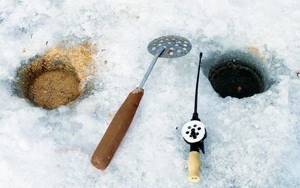
Tactics for catching roach in winter involve drilling and feeding several holes, followed by checking. If there are no bites, then we move on until the roach’s parking place is found. For the first and last ice, you don’t have to wait long and don’t need to feed a lot. A little feeding, 5 minutes to check the hole. In the middle of nowhere, we wait longer, sometimes even a couple of hours (especially if the angler is sure that the fish are here). In the middle of winter, roaches gather for quite a long time, as they move slowly and reluctantly.
The mistake that novice fishermen make when feeding roach is to feed them one time or over an area. Feed correctly - a little bit at a time throughout the entire fishing trip. Therefore, when searching, do not make holes closer than 10 meters (so as not to feed over the area, as a result of which the fish will scatter throughout this area). If there are bites, do not forget to throw a pinch of food into the hole every 10-15 minutes, otherwise the roach will leave.
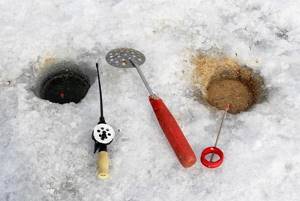
You can't pour too much. For starting feeding, one ball (dump truck) per hole is enough. And if the process has started, then periodically it is necessary to supplement the food in small portions - one ball the size of a walnut or less. The same algorithm is used for night fishing from ice.
When the roach is actively biting in the water column, dry bait is poured directly into the hole to form a feeding column that holds the fish. When actively fishing with a reelless bait, you can also feed it. To do this, several holes are drilled, a small ball of fertilizer is thrown into each, and then a check is made.
Tactics for forming feeding tables
Winter fishing for roach with bait can be done using feeding tables.
This approach will be relevant under the following conditions:
- No flow;
- Large body of water (reservoir);
- The time is deep winter;
- Knowing that there are a lot of large roaches here;
- The ability to frequently visit a reservoir and accurately locate the feeding site (for example, using GPS);
- Other fishermen did not “burn” all these manipulations.
A feeding table is being formed in a promising area. To do this, drop 1-2 buckets of porridge into the hole. From experience, plain millet works better. You cannot add any additives to the porridge - just boiled cereal is used. The hole is remembered and left for two days.
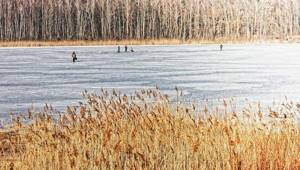
After two days, the fisherman arrives at the site, drills out the same hole and feeds it with a small amount of bait. And after that it catches with animal baits. The peculiarity is that the fish on the table will be already full, so it is important to use attractive bait when fishing. In addition to roach, bream or large crucian carp are gathered on such a table, which will stand in the remains of the porridge and rummage through them. In this case, the roach will scurry higher, trying to win food competition through speed and activity.
The table must be made in places where fish are known to be present. Otherwise, this porridge will simply lie at the bottom and rot. If everything works out, the important place is used for a long time, updating the feed at the end of fishing trips. Periodic feeding of roaches in winter can keep the flock in one place for a long time.
Over time, the largest fish from the surrounding waters gather at this place (if they are generally poorly fed). The fish will literally stand on the feeding spot, driving away the small things as competitors. This tactic works in reservoirs with weak fishing pressure, but in the Moscow region there is a high probability that other subglaciers will quickly find such a secret point.
Application of bait (feeding technique)
The technique for feeding roach depends on where the fishing spot will be.
For dump truck
An opening feeder (or dump truck) is used when fishing for roach in reservoirs with standing water or with a small current. Drill a hole a little above the hole and pour bait into it. Then the mixture will go directly to the roach fishing spot. The action of the feeder consists of the following stages:
- bait is poured into the feeder (a little more than half);
- the lid closes;
- a retaining ring is inserted;
- the feeder is lowered into the pond;
- the device sinks to the bottom of the reservoir;
- wait about 10-15 seconds;
- open the lid of the feeder with a sharp movement of your hand so that its contents end up at the bottom.
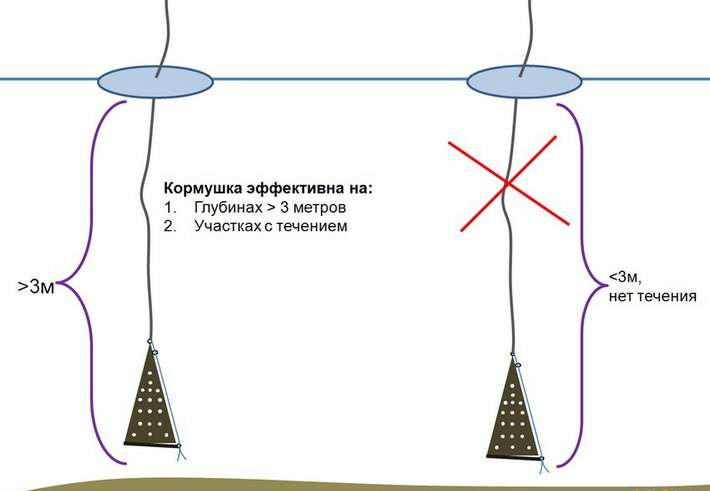
Open the feeder with bait at a distance of 0.5 - 2 meters from the bottom. Then the fish will be less afraid. During repeated feeding, the feeder opens a little higher than the first time.
On the current
Feeding roach in a river differs significantly from feeding it in reservoirs with stagnant water or a slight current. The main difference is that when fishing like this, heavy ingredients are added to the bait, for example, king prawns. Such a mixture will not be carried away so much by the current and will attract fish to the fishing spot.
If there is a current, feeding directly into the hole or using a feeder is not suitable. In such cases, the bait will be carried away by the current.
In winter, if there is a current, the best option is to feed the roach just above the fishing spot. To do this, drill another hole at a short distance. It depends on factors such as the depth of the reservoir, the speed of the current and its direction. In weak currents, a good effect is observed when feeding fish with small balls. To do this, make several lumps from the mixture and carefully place it into the hole.
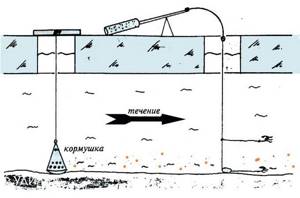
Feeding is carried out using a regular feeder or a dump feeder. The main task is to ensure that the bait mixture lies strictly at the bottom of the reservoir, and does not simply wash out. If everything is done correctly, the aroma of the bait will attract roaches to the fishing spot.
As a proven bait on the current, we can recommend the following option: Mix 200 g of fried sunflower seeds, 1 cup of chopped tangerine zest, a package of rye crackers, 200 g of wheat porridge, 2 tbsp. wheat flour, chopped king prawns. It is better to prepare the mixture at home, and during fishing itself a small amount of water is added to the bait. The mixture should be medium thick.
Make the first feeding in a hole drilled upstream. The mixture enters the reservoir using a feeder or “by hand”. In the first case, the bait is introduced into the feeder and lowered into the pond. In the second option, several small balls are made from the mixture. They need to be slightly frozen for 3-5 minutes. This is done so that the lumps stick better. Feed the roach throughout your fishing trip.
The main feature of this bait is the presence of crushed shrimp. They give the bait mixture its own unique aroma. Gradually spreading downstream, it will begin to attract roaches to the fishing site.
In addition, shrimp have more weight than standard bait components (sunflower seeds or rye crackers), due to which the majority of them will be on the bottom. And this is a very important point, since this is the only way shrimp can attract a school of roach to the fishing spot.
This bait recipe is time-tested and is perfect for fishing in the winter when fishing in the current.
On still water
In a reservoir with stagnant water, bait can be thrown directly into the fishing spot, into the hole. This is done if the roach is above the bottom. If the fish is caught on the bottom, then it is better to form small balls from the bait and throw them into the hole. Note that in order to form a cloudy column that will attract fish, make one of the lumps of the mixture loose. Due to this, the ball will disintegrate and the mixture will form an attractive haze.
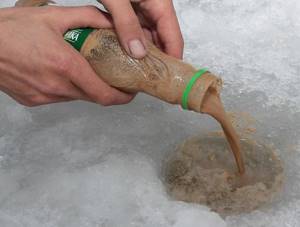
The most effective way to feed fish at depth is to use a feeder. With its help you can put bait directly on the bottom under the hole. Then the roach will stand in a flock in the fishing area.
In shallow water, you need to feed the roach by throwing the bait in bulk into the hole. The aroma of the mixture and the turbidity formed as a result of entering the reservoir. A prerequisite for fishing in shallow water is light weight bait. The bloodworm at such a depth must be thrown directly “from hand” directly under the ice. Closer to spring, bait of animal origin is constantly shaken into the hole, due to which the roach itself rises after the falling food.
Store-bought baits
It is rational to use bait from the store in the following cases:
- For fishermen of one day, who rarely go fishing, are not particularly sick of it, and sometimes go out to the pond to get some air.
- For sport fishing competitions.
- On casual fishing trips, when there was simply no time to prepare.
- As an aromatic additive in homemade fertilizer (and this is exactly our case).
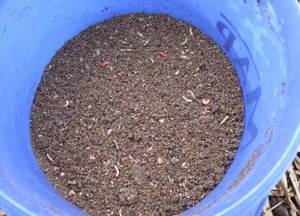
Now there are a huge number of offers on the market, it is difficult to identify manufacturers of the best winter bait for roach. When choosing, consider the factor that a special mixture is used in winter. It says on the bag: “For cold water.” Or something like that. This is important because odors spread slowly in cold water in winter.
Therefore, winter bait should have a weak but very persistent aroma that does not disappear over time. There is no absolute and most catchy option - in different bodies of water, roach may prefer completely different compositions. Only direct experience will help determine the truth.
Positive reviews about the good performance of store-bought winter baits for roach on fishing forums are often found on the following products:
- Dry Blooder (dry blood).
- Dragon Elite bait, black, roach.
- Sensas 3000.
- Dunaev.
- Traper.
- FishDreamElite.
- Chip.
When buying a store-bought mixture, pay attention to the expiration date! Rancid and old moldy fertilizer will ruin your entire fishing trip.
Making bait for roach
Bait for winter roach should consist of the following components, each of which will be discussed separately:
- Base (cereal).
- Components (binders or loosening agents, drying agents).
- Dusting components.
- Flavors.
- Live bloodworms or other animal supplements.
- Sweeteners and dyes.
An impressive list? In fact, it's simple. This division is necessary for the understanding of the process of bait operation. In addition to the composition, the method of application is important. This has already been said in the first part of the article. Feeding roach on the first ice is minimal. In the dead of winter we feed more. If you don’t know what to feed your sorog in winter during a one-time short fishing trip, just buy a bag of store-bought mixture. You won’t find the best bait for catching roach in winter in the store, but you can prepare it yourself.
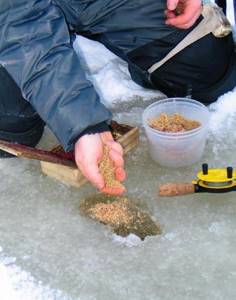
Correct consistency and particle size
As already mentioned, the final mass needs to be loose, but at the same time it should allow the formation of balls that will easily disintegrate at the bottom over time into small particles. Sorog bait should not lie on the bottom in a layer or in one piece. For winter roach, the particles should not be large, the size should not exceed 1.5 millimeters. A good bait for roach in winter has a finely dispersed structure.
Mixture base
The classic and excellent basis for feeding sorog in winter is millet. The second most popular is medium-ground corn grits. A mixture based on boiled peas in puree also works very well. Some anglers use egg and wheat, but these grains work worse. You should not rely on just one recipe for homemade bait for roaches in winter. In one case, millet will work better. In another case, bait for winter fishing for roach made from corn will show good results.
So, let's start cooking the porridge. Take millet (or corn grits), add it to boiling water and cook in plenty of water for 10 minutes. The cereal does not need to be cooked completely; as soon as it swells, drain the water and rinse thoroughly under a cold tap through a mesh colander, stirring with a spoon. The goal is to remove gluten from the cereal. As a result, the base turns out crumbly and does not stick together.
Millet
Binding and loosening components
Roughly speaking, this is the next level in particle size. We add smaller particles to our bait for chebak (Siberian subspecies of roach). This role may include:
- Breadcrumbs.
- Ground peas into flour.
- Bran.
- Semolina.
These components (except for crackers) can unnecessarily glue the bait together. You can add them a little. In any case, by adding crackers, we bring the consistency to the desired level - the balls are molded, but when pressed they crumble.
Dusting components
Add a little dry milk to our mixture. If you don't have it, rolled oats ground into flour will do. These components will create a whitish cloud in the water. Natural milk powder is better. The roach likes the smell of milk, so it feeds well on the udder in winter.
Corn grits - an alternative base
Flavorings for bait
Now add some scent to the mixture. There are many known flavors for ice fishing for roach. You don't have to buy these expensive bubbles at a fishing store. For our purposes, improvised means are suitable. In the fishing community, there is debate about the saturation of bait with flavorings. Most people are sure that for winter fishing you need to add odorous elements very carefully, just a little. But there are also reviews about the successful use of strong-smelling baits.
Roasted sunflower seeds
The simplest and most effective option is to add ground roasted sunflower seeds and vanilla. It should be understood that you cannot mix many scents - you need to use only one (maximum two) at a time. And then, during fishing, find out the most effective one.
Flavors for ice fishing for roach:
- ground roasted sunflower seeds (makukha, cake);
- vanilla;
- anise;
- ground dried tangerine peel;
- ground hemp seeds;
- ground dill seeds;
- ground coriander seeds;
- vanilla cookies;
- mint gingerbread;
To our basic bait we will add ground sunflower seeds and a couple of mashed vanilla cookies (or mint gingerbread).
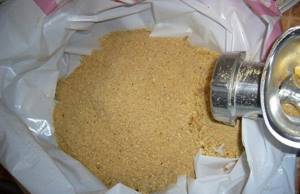
Grinding cookies and crackers
Animal components
It is advisable to add these elements if they are available, but it is not always possible to get them:
- feed bloodworm;
- mormysh;
- aquarium food (dried daphnia);
- ground zebra mussels;
- chopped shrimp (not missing! 2-3 pieces).
Addition of food bloodworms
Sweeteners
It’s no secret that roaches love sweets, so you can sweeten the bait a little with sugar or honey. The addition of halva shows good results.
Mint gingerbread
Color
For the ideal composition, you can also take into account the color of the roach bait. But this is, again, a question of the preferences of the fish in a particular body of water. The generally accepted opinion is that the color of the mass should not differ much from the general background of the bottom. Too light bait on a dark bottom can negatively affect the bite. I usually don’t bother like this - millet with fried seeds is already quite dark in color.
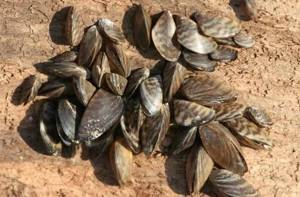
Dreissena shell
Dump feeder
To place winter bait on roach in a promising fishing spot, it is advisable to use a high-quality feeder. As an example, we can take a popular design with the popular name “dump truck”. It works on a simple principle, which consists of lowering the container with the composition to a depth using a fishing line. As soon as the line runs out, this provokes the opening of the device, as a result of which the mixture sinks to the bottom. The purpose of this feeder is to attract fish to a specific fishing point.
Design features
Similar mechanisms are sold in every fishing store, although they are easy to make yourself using available tools and materials. First you need to understand the key elements that make up the feeder. So it includes:
- A special container where the composition is placed.
- Mechanism that opens the hinged bottom.
- Folding bottom.
- Cord or any other rope.
It makes sense to use such a feeder when fishing in still waters or in small currents. First you need to drill a hole, and then lower the structure there using a fishing line or cord. As soon as it is at the bottom, it is necessary to open the hinged bottom with a sharp, but at the same time light movement. The prepared composition will begin to spread throughout the water column.
Step-by-step manufacturing guide
Creating such a device is relatively simple. To do this, just follow these instructions:
- First you need to draw a square measuring 30x30 centimeters on a piece of paper. The finished “pattern” is placed on a sheet of galvanized sheet and the blank is cut out. Then, using a marker, points are placed on this product where holes will need to be drilled.
- At the next stage, the sheet of tin must be rolled into a cone and equipped with a loop of steel wire at the top. The fishing line or cord will pass through this loop.
- Then you need to prepare the cover for the structure. To do this, an outline of the base of the cone is created on a sheet of paper, and the location of the loop for the lock is also indicated. It is depicted as a small protrusion, and then the “pattern” is transferred to metal and cut out. In the loop of the “lock”, using a marker, a hole with a diameter of 0.8-1 centimeters is indicated. Then it is drilled. To prevent fishing line snagging during operation of the structure, it is necessary to first sand the edges of the cover.
- The lid may have a single-point fastening, which is made opposite the hinge. In this case, a hole is made at the upper and lower edges of the feeder, where a factory ring or ordinary wire is placed. These will be used to secure the lid to the feeder cone.
- To ensure free opening of the lid without problems, it is necessary to attach a lead washer or a 10-15 gram plate to the structure. This is done from the outside of the lid.
The best bait recipes for roach in winter
This is the best homemade winter bait recipe for roaches.
A simple and always working option:
- Boiled millet, washed with water.
- Breadcrumbs.
- Roasted seeds.
- Pea flour.
You can improve it by adding, for example, ground biscuits and bloodworms. You need to experiment with this composition of winter bait for roaches without changing the essence of the preparation algorithm. The only exception is bait based on pea puree.
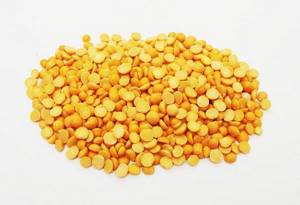
Peas
Boiled pea porridge is very viscous, and to bring the mixture to a crumbly state you need to add a sufficient amount of dry ingredients - ground seeds and breadcrumbs. The rest of the approach is similar.
Preparing effective winter baits for fishing is possible right in your kitchen, without any special frills or complex technological processes. And such products are often much more effective and cheaper than store-bought bait.
Subscribe to the channel:
My YouTube channel RYBAFAN on fishing:
We're OK
Preparing complementary food for roaches
With your own hands you can create a truly effective and attractive bait mixture that will attract fish from a long distance. There are indeed a lot of recipes for preparing such compositions, and each of them will be relevant in a specific place and at a specific time. Each bait is pre -mixed with water directly on the surface of the ice. It is important to maintain the thickness, making it medium. Then you need to give the mixture 15-20 minutes so that it takes on the appropriate consistency.
One of the most popular cooking recipes is “Corn”. It consists of the following ingredients:
- 250 g corn.
- 300 g rye crackers.
- 50 g hemp grains.
- 150 g ground buckwheat.
- 100 g ground pearl barley.
- 100 g dry peas.
- 30 g ground citrus zest.
- 30 g coriander.
- 30 g ground dried basil.
- 10 g table salt.
All components should be thoroughly mixed, after which the bait can be thrown into the holes. If you comply with the above quantities of ingredients, then this will result in a full kilogram of homemade complementary food, which is quite enough for one-day fishing.
Bait on crackers also works well. To prepare it, use: rye crackers, ground fried buckwheat, corn grits, oatmeal, cinnamon or coriander. All ingredients are thoroughly mixed until a homogeneous mass is formed.
You can also try preparing heavy bait using rye crackers, milk powder, anise, bloodworms or chopped worms, sand or clay and earth (depending on the presence of a current).
When composing the mixture, one should not forget about its aromaticity. In this case, various store-bought or homemade scents are used. The main thing is not to overdo it with their volume, because excessive aroma will only scare away the fish. Roaches are especially attracted to vanilla, hemp and anise.
